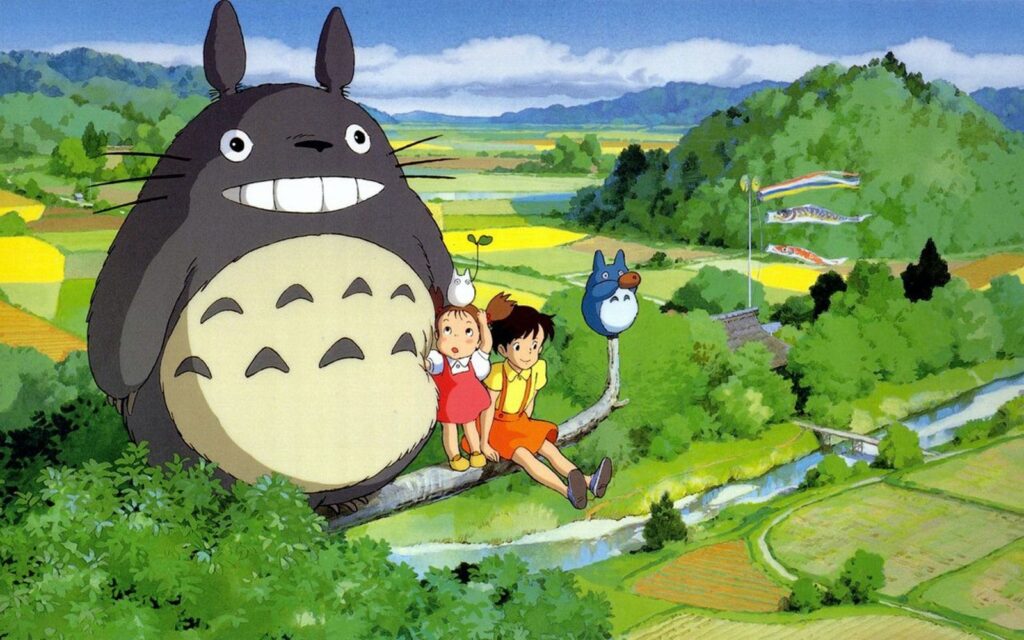Written and directed by Hayao Miyazaki
The two girls enter the house. They don’t want to be here, away from friends and school. But their mother is in a rural hospital, and dad has moved them to this rental to be closer to her. In the midst of this unease, they open a door and black shapes scurry into the corner. The house, it seems, is haunted. Later, Mei encounters two rabbit-like spirits that lead her into a dense copse. There resides a giant creature, asleep. When Mei awakens him, he roars loudly. Mei roars back, giggling in delight.
It’s easy to forget that given Mei and sister Satsuki’s situation, these spirits could be menacing. Are they manifestations of the girls’ fears? Not so fast. This is a Japanese film, rooted in Shinto animism. They are kami—nature spirits—but maybe not like any kami we know. Mei, Satsuki, and their father are friends to the natural world. So then the giant Totoro and his cadre are friends to them. Lesson one: live in harmony with nature.
The humans are also innocent, especially young Mei. She doesn’t think to be frightened by Totoro’s powerful roar. Instead, she’s at play, and the cat-like behemoth is happy to oblige. He gives Mei a sack of seeds, which the girls dutifully plant. They come out at night to find Totoro and his subordinate spirits coaxing life from the seeds, and they explode into a glorious fully-grown tree. The magical nighttime romp has all the makings of a pagan ritual, but instead of capping it with a blood sacrifice, Totoro magically lifts the girls into the sky for a moonlight flight.
I’ve always loved the animators of Studio Ghibli for their comfort in three dimensions. During the flying scene, the characters whiz by the camera, wind whipping hair and skirts, then recede into the background. There is magic, there is mystery, but interestingly there is never fear. The giant Totoro is intimidating, and in another movie, the black soot sprites could portend doom. Not here. That makes My Neighbor Totoro an ideal movie for young children. Lesson two: just because something is strange doesn’t make it scary.
The closest we get to fear is near the end, when a visit to mom has to be put off. Mei is more petulant than frightened—she wants to be with her mother—and sets off on the long trek alone. Satsuki, at first skeptical of the spirits but now a true believer, calls on Totoro for help. He summons the passenger bus they rode before—one that’s actually a hollowed-out living cat—and has the Cheshire-grinned transport find Mei. Nothing like a twelve-pawed catbus to oblige.
A final note about the movie’s visual delight—freeze any frame and you’ll get bright colors and beautiful landscapes. Totoro is plush and approachable, and even the black soot sprites bump into one another comically. Mei is somewhat cartoonish, unlike the more “realistic” Satsuki, which places her halfway between the human and kami worlds. Compare this to other Miyazaki films, where his imagination creates more frightening creatures like Princess Mononoke’s plague-demon or Yubaba, the mistress of the supernatural realm in Spirited Away. Like every good kid adventure, My Neighbor Totoro belongs to the children—the parents never see or meet the magical creatures, but neither do they disbelieve the kids. This is another point that makes My Neighbor Totoro a compelling and comforting movie for the whole family. It’s as if parents and children are playing together in a mystery-filled world, with grown-ups providing grounding and children contributing hopeful joy. We know everything will be okay with mom and with dad. They have Totoro looking out for them.

